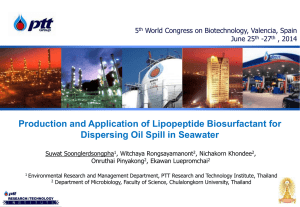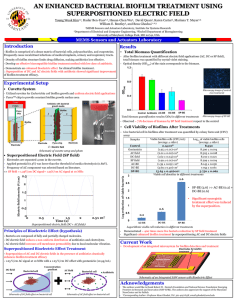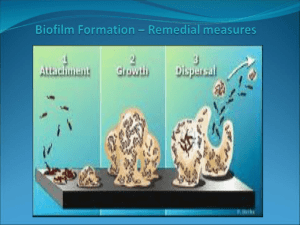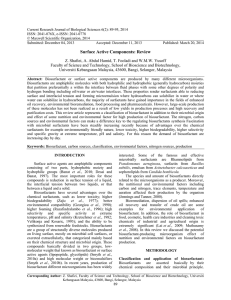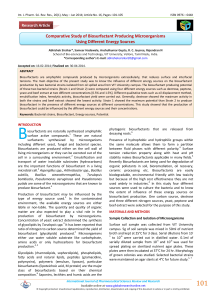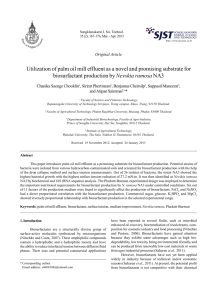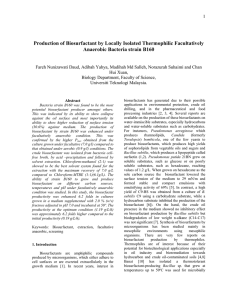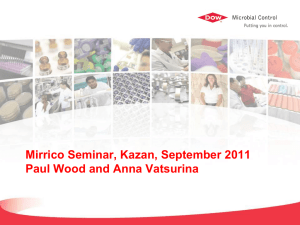BIOFILM INHIBITORY ACTIVITY OF BIOSURFACTANTS ISOLATED
advertisement
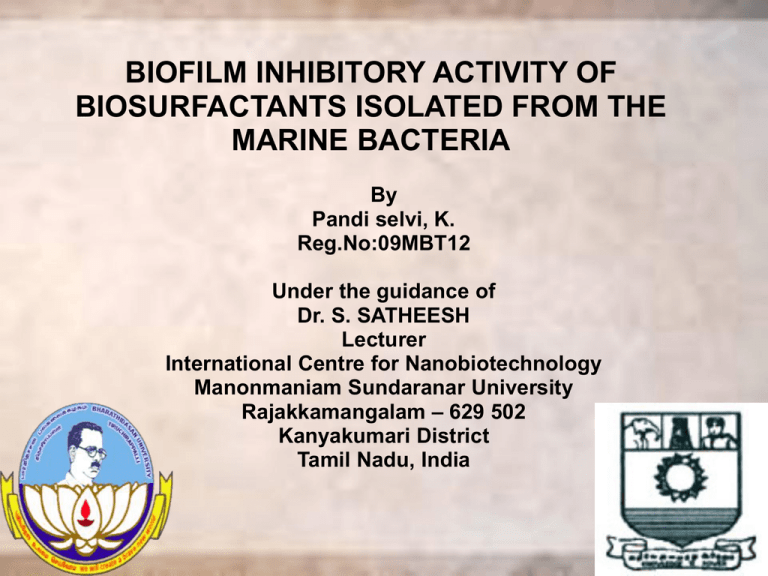
BIOFILM INHIBITORY ACTIVITY OF BIOSURFACTANTS ISOLATED FROM THE MARINE BACTERIA By Pandi selvi, K. Reg.No:09MBT12 Under the guidance of Dr. S. SATHEESH Lecturer International Centre for Nanobiotechnology Manonmaniam Sundaranar University Rajakkamangalam – 629 502 Kanyakumari District Tamil Nadu, India Synopsis • • • • • • • Introduction Objectives Materials and Methods Results and Discussion Summary Acknowledgement References INTRODUCTION • Biofilm is an assemblage of microbial cells that is irreversibly associated with a surface and enclosed in a matrix of primaroly polysaccharide material. • Biofilm form when bacteria adhere to surfaces and begin to excrete a glue-like substance that protects and anchors them to material such as metals such as metals, plastic, soil, medical implants and tissue. Cont… • In industry, biofilms can cause corrosion of pipes, reduce heat transfer in cooling systems and plug water filters. • The major difficulties in controlling surface-attached bacteria is their enhanced resistance to antimicrobial agents. • Surface active compounds (surfactants) have been empolyed to prevent bacterial adhesion to surfaces. CONTROL OF BIOFILM • A biofilm control programme is detection and assessment of various biofilm components like thickness of slime layer, algal and bacterial species involved, extent of extracellular polymeric substances (EPS) and inorganic components. • The new techniques for biofilm control like ultrasound, electrical fields, hydrolysis of EPS and methods altering biofilm adhsion. BIOSURFACTANT • Surfactants both chemical and biological are amphiphilic compounds which can reduce surface and interfacial tensions by accumulating at the interface of immiscible fluids. • It play an essential role in the swarming motility of microorganisms and participate in cellular & physiological processes of signalling and differentiation as well as in the biofilm formation. Cont… • There are several advantages over the chemical surfactants such as lower toxicity, higher biodegradability, better environmental compatibility, higher foaming , high selectivity and specific activity at extreme temperatures, pH and salinity and the ability to synthsized from renewable feedstock. OBJECTIVES • to isolate and characterize the biosurfactant from seaweeds and gastropods, • to check the antibacterial activity, • to analyse the impact of biosurfactant on bacterial adhesion, • to characterize the biosurfactant by TLC, HPLC & NMR. MATERIALS AND METHODS • Isolation of surface associated bacteria (SAB), • Biochemical characterization of isolated bacterial strains, • • • • • • • • • • • Gram’s staining Motility test Indole production test Methyl-red test Voges-proskauer test Citrate utilization test Starch hydrolysis Urea hydrolysis Fermentation of carbohydrate Catalase test Gelatin hydrolysis test Cont… • Isolation of biosurfactant (Oil displacement test), • Antibacterial activity of biosurfactant against biofilm bacteria, • Influence of biosurfactants on the adhesion of biofilm bacteria to surface, • Characterization of biosurfactant by TLC, HPLC & NMR. Results and Discussion + - Positive • - Negative S1 - Seaweeds S2 - Seaweeds S3 - Seaweeds S4 - Seaweeds G1 - Gastropods Biosurfactant screening methods Antimicrobial activity of biosurfactant isolates from the srain S1, S2 against target bacteria Antimicrobial activity of biosurfactant isolated from the strain S 3, S4 & G1. Adhesion assay using biosurfactant of the strain S1 & S 3 (number of bacterial cells adhered on glass coupons) Thin layer chromatogram of the biosurfactant isolated from the strain S1, S2, S3, S4 & G1. HP LC spectrum of biosurfactant isolated from the strain S1 H P LC spectrum of biosurfactant isolated from the strain S 3 H P LC spectrum of biosurfactant isolated from the strain S4 1 H NMR spectrum of the biosurfactant isolated from the strain S 3 13 C NMR spectrum of the biosurfactant isolated from the strain S3 DISCUSSION • In conclusion, result of the present study revealed that bacteria associated with marine invertebrates and seaweeds has the potential to produce biosurfactants. • Further studies on this aspect may improve our knowledge on the application of these biosurfactants in biomedical and environmental field. SUMMARY • The present study was carried out to assess the biofilm inhibitory activity of bacteria associated with seaweeds and gastropods. • Biosurfactant was tested for antimicrobial activity against five bacterial strains (E.coli, Bacillus sp, Klebsiella sp, V. harveyi, V. parahaemolyticus). • The biosurfactant was characterized by TLC, HPLC & NMR. • Further studies on biosurfactants, provides tremendous applications in industrial fields as detergents in biomedical and therapeutical fields. ACKNOWLEDGEMENT • I owe to almighty God and my beloved mother for their blessings and help, without which I might never have been successful. • It is my privilege to express my deep sense of gratitude and sincere thank to my guide Dr. S. Satheesh, Lecturer, International Centre for Nanobiotechnology, Rajakkamangalam for providing necessary facilities to carry out my project in this institution. • It is my privilege to express my deep sense of gratitude and sincere thank to my co-guide Dr. S. G. Prakash Vincent, Associate Professor, for his invaluable contribution, encouragement, optimistic approach in any problem and systematic guidance to make this out a successful project. • I take this opportunity to express my hearty thanks to Dr.L.Uma, Head Department of Marine Biotechnology, Bharathidasan University, Trichy, Dr.S.Mary Josephine Punitha, Assistant Professor, Dr.G. Immanuel, Assistant Professor, Dr. T. Citarasu, Assistant Professor for their encouragement and support throughout this study. • I would like to express my hearty thanks to my beloved friends and scholars who helped me directly and indirectly for the completion of my project work. • I wish to express my sense of appreciation to my sisters who patiently endured and gave encouragement and support throughout my studies. • Once again I thank to god for making everything possible with the help of our guides, family members, friends and everyone who helped me. (K.Pandi selvi) REFERENCES 1. Armstrong, E., Yan, L., Boyd, K.G., Wright, P.C. and Burgess, J.G. (2002). The symbiotic role of marine microbes on living surfaces. Hydrobiologia. 461: 37-40. 2. Bagge, N., Schuster, M., Wentzer, M., Ciofu, O., Givskov, M., Green berg, E.P. and Hoiby, N. (2004). Pseudomonas aeruginosa biofilms exposed to imipenem exhibit changes in global gene expression and βlactamase and alginate production. Antimicrob. Agents chemother, 48: 1175-1187. 3. Banat, I.M. (1995). Biosurfactant production and possible uses in microbial enhanced oil recovery and oil pollution remediation. Biores. Tehnol, 51: 1-12. 4. Banat, I.M., Makkar, B.S. and Cameotra, S.S. (2000). Potential commercial applications of microbial surfactants. Applied microbial. Biotechnol., 53: 495-508. 5. Beccerro, M.A., Uriz, M.J. and Turon, X. (1997). Chemically mediated interactions in benthic organisms : the chemical ecology of Crambe crambe ( Prolifera Poeciosclerida). Hydrobiologia 335: 77 – 89. 6. Bodour, A.A., Drees, K.P. and Maier, R.M. (2003). Distribution of biosurfactant-producing bacteria in undisturbed and contaminated arid southwestern soils. Applied Environ. Microbial., 69: 3280-3287. 7. Bognolo, G. (1999). Biosurfactants as emulsifying agents for hydrocarbons. Colloids Surf. A Physiochem. Eng.Asp., 152: 41-52. Cont… 8. Cameotra,S.S. and Makkar, R.S. (1998). Synthesis of biosurfactant in extreme conditions. Appl.Microbial.Biotechnol. 50: 520 – 9. 9. Branda, S.S; Vik, S; Friedman, L. and Kolter, P. (2005). Biofilms: the matrix revisited. Trends Microbial. 13: 20-26. 10. Burholder, P.R., Pfister, R.M. and Leitz, F.P. (1966). Production of a pyrrole antibiotic by a marine bacterium. Appl Microbial 14: 649 – 653. Cameotra,S.S. and Makkar, R.S. (1998). Synthesis of biosurfactant in extreme conditions. Appl.Microbial.Biotechnol. 50: 520 – 9. 11. Carte, B.K. (1996). Biomedical potential of marine natural products Bioscience, 46: 271 – 286. 12. Cedenir Pereira de Quadros., Marta Cristina Teixeira Duarte, and Glaucia Maria pastore. (2011). Biological activities of a mixture of biosurfactant from Bacillus subtilis and Alkaline lipase from Fusarium oxysporum. Brazilian Journal of microbiology., 42:354-361. 13. Characklis, W.G., McFeters, G.A. and Marshall, K.C. (1990). Physiological ecology in biofilm systems. In: Characklis, W.G., Marshall, K.C. editors. Biofilms. New York: John Wiley and Sons., pp. 341-94. 14. Christensen, G.D; Baddour, L.M; Hasty, D.L; Lowrance, J.H. and Simpson, W.A.(1989). Microbial and foreign body factors in the pathogenesis of medical device infections. In: Infections associated with indwelling medical devices. Edited by Bisno, A.L. and Waldvogel, F.A. American Society of Microbiology, Washington DC.27-59. Cont… 15. Ciofu. O., Fussing, V., Bagge, N., Koch, C. and Hoiby, N. (2001). Characterization of paried mucoid nonmucoid Pseudomonas aeruginosa isolates from Danish cystic fibrosis patients antibiotic resistance, β lactamase activity and Ribo printing. J. Antomicrob. Chemother, 48: 391-396. 16. Clare, A.S. (1998). Towards non-toxic antifouling. J. Mar. Biotechnol 6: 3-6. 17. Clare, A.S., Ritschoff, D., Gerhart, D.J., Hooper, J.R. and Bonaventure, J. (1999). Antisettlemnt and narcotic action of analogues of detepine marine natural product antifoulants from octocorals. Mar.Biotechnol. 1: 427 – 436. 18. Cloete, T.E. and Jacobs, L. (2001). Surfactants and the attachment of Pseudomonas aeruginosa to 3CR12 stainless steel and glass. ISSN 0378-4738 = water SA Vol.27, No.1,21-26. 19. Cooper, D. and Goldenberg, B. (1987). Surface-active agents from two Bacillus species. Appl. Environ. Micribiol., 53: 224-229. 20. Costerton, J.W., Lewandowski, Z., Caldwell, D.E., Korber, D.R., Lappin – Scott, H.M. (1995). Microbial biofilms. Ann. Rev. Micribial., 49: 711-745. 21. Costerton, J.W., Stewart, P.S. and Greenberg, E.P.(1999). Bacterial biofilms a common cause of persistent infections. Science 284: 1318 – 1322. Cont… 22. Dagastino, L., Goodman, A.E. and Marshall, K.C. (1991). Physiological responses induced in bacteria adhering to surfaces. Biofouling, 4: 113 -119. 23. Dalaguis, P.J., Cadwell, D.E., Lawrence, J.R. and WcCurdy, A.R. (1989). Detachment of Pseudomonas huorescens from biofilms on glass surface in response to nutrient stress. Microb. E.coli., 18: 199-210. 24. Deepika Lakshmipathy, T., Arun Prasad, A.S., and Krishnan Kannabiran. (2010). Production of biosurfactant and Heavy metal resistance activity of Streptomyces sp. VITDDK- a Novel Halo Tolerant Actinomycetes isolated from saltpan soil. Advances in Biological Research 4(2).108-115. 25. Desai, J.D. and Banat, I.M. (1997). Microbial production of surfactants and their commercial potential. Microbiol. Mol. Biol. Rev., 61:47-64. 26. Dexter, S.C., Sulliven, J.D., Williams, J. and Watson S.W. (1975). Influence of substrate wattability on the attachment of marine bacteria to various surfaces. Applied Microbiology. 30: 298 – 308. 27. Drenkard, E. (2003). Antimicrobial resistance of Pseudomonas aeruginosa biofilms. Microbes infect, 5: 1213-1291. 28. Faruque, S.M., Biswas, K., Udden, S.M.N., Ahmad, Q.S., Sack, D.A., Nair, G.B. and Mekalanos, J.J. (2006). Transmissibility of Cholera: in vivo-formed biofilms and their relationship to infectivity and persistence in the environment. Proc Natl Acad Sci USA, 103: 6350-6355. Cont… 29. Gerard, J., Haden, P., Kelly,M.T. and Andersen, R.J. (1996). Lolaatin B, a cyclic decapeptide antibiotic produced in culture by a tropical marine bacterium. Tetrahedron Lett. 37, 7201 – 7204. 30. Ghurye, G.L. and Vipulanandan, C. (1994). A practical approach to biosurfactant production using nonaseptic fermentation of mixed cultures. Biotechnol. Bioeng.,44: 661-666. 31. Gilbert, P. Das, J. and Folely, I. (1997). Biofilm susceptibility to antimicrobials, Adv Dent Res, 11: 162-167. 32. Gutnik, D.L., Shabtai, Y. (1987). Exopolysaccharide bioemulsifiers. In: Kosaric, N., Caims, WL., Gray NCC, editors. Biosurfactants and biotechnology. New York : Dekker, P; 211-46. 33. Hammer, B.K. and Bassler, B.L. (2003). Quorum sensing controls biofilm formation in Vibrio cholerae. Mol Microbiol, 50: 101-114. 34. Harrison, J.J., Turner, R.J. and Marques, R. (2005). Biofilms. Am.Sci., 93(6); p.513. 35. Holmstrom, C., Rittschof, D. and Kjelleberg, S. (1992). Inhibition of settlement of larvae of Balanus Amphitrite and Clina intestinalis by a surface-colonizing marine bacterium. Appl. Env. Microb 58: 2111-2115. 36. Howard, A..E. (1994). The possibility of long distance transmission of Bonamia by fouling on boat hulls. Bulletin of the European Association of Fish Pathologists 14 (6):211 – 212. Cont… 37. Huang, S. And Hadfield, M.(2003). Composition and density of bacterial biofilms determine larval settlement of the polychaete Hydriodes elegans. Mar. Ecol. Prog. Ser. 260: 161 – 172. 38. Isoda, H., Kitamoto, D. and Shinmoto, H. (1997). Microbial extracellular glycolipid induction of differentiation and inhibition of protein kinase C activity of human promyelocytic leukaemia cell line HL60. Biosci. Biotechnol. Biochem. 61: 609-614. 39. Jain, A., Nlshad, K.K., Narayan, K.K and Bhosle, B. (2007). Effects of DNP on the cell surface properties of marine bacteria and its implication for adhesion to surfaces. Biofouling, 23: 171-177. 40. James, G., Holmstrom, C. and Kijelleberg, S. (1996). Purification and characterization of a novel antibacterial protein from the marine bacterium D2 App. Env. Microb. 62: 2783-2788. 41. James, G.A., Korber, D.R., Caldwell, D.E. and Costerton, J.W. (1995). Digital image analysis of growth and starvation responses of a surface colonizing Acinetobacter sp. J. Bacteriol., 177: 907-915. 42. John Wiley and sons. (2007). Biofilm Formation. 43. Jonathan, D., Van Hamme., Ajay Singh., and Owen P.ward. (2006). Physiological aspects part 1 in a series of papers devoted to surfactants in microbiology and biotechnology. Biotechnilogy Advances. 24, 604620. Cont… 44. Kirchman, D., Graham, D., Reish, D. and Mitchell, R. (1982). Lectins may mediate in the settlement and metamorphosis of Janua (Dexiospira) brasiliensis, Grube (Polychaetea spirorbidae). Maro Biol. Let. 3: 201-222. 45. Komorek, V. and Wilk, K.A.(2004). Surface and miceller properties of new non-ionic Gemini aldonamide – type surfactants. J. colloid interface Sci, 271: 206-11. 46. Kuyukina, M.S., Ivshina, I.B., Makarov, L.V., Litvinenko, C.J., Cunningham, and Philip, J.C. (2005). Effect of biosurfactant on crude oil desorption and mobilization in a soil system. Environ. Int., 31:155-161. 47. Lau, S.C.K. and Qian, P.Y. (1997). Phlorotannins and related compounds as settlement inhibitors of a tube louiding polychaete Hydroides elegans (Haswell) Mar. Ecol. Prog. Ser. 159: 219-227. 48. Lemos, M.L., Toranzo, A.E. and Barja, L.J. (1986). Antibiotic activity of epiphytic bacteria isolated from intertidal seaweeds. Mirob. Col. 11, 149 – 163. 49. Lewandowski, Z. and Beyenal, H. (2005). Biofilms their structure, activity, and effect on membrane filtration water Sci Technol 51(6-7): 181-92. 50. Ligia Rodrigues., Ibrahim M. Banat., Jose Teixeira. And Rosario Oliveira. (2006). Biosurfactants : Potential application in medicine. Journal of antimicrobial Chemotheraphy. 57: 609-618. Cont… 51. Lin, S.C. (1996). Biosurfactant:recent advances. J. Chem. Technol. Biotechnol. 66: 109 – 20. 52. Maki, J. (2002). Biofouling in the environment. In: Bitton, H., editor. Encyclopedia of environmental microbiology. New York: Wiley and sons. pp 610-619. 53. Maki, J.S., Rittschof, D., Costlow, J.D. and Mitchell, R. (1998). Inhibition of attachment of larval barnacles, Balanus Amphitrite, by bacterial surface films. Mar. Biol. 97: 199-206. 54. Makkar, R.S. and Cameotra, S.S. (1997). Utilization of molasses for biosurfactant production by two Bacillus strains at thermophilic conditions. J. Am. Org. Chem. Soc., 7: 887-889. 55. Marshall, J.C. (1988). Adhesion and growth of bacteria at surfaces in oligotrophic habitats. An. J. Microbial., 34: 503-506. 56. O’Toole, G.A., Gibbs, K.A., Hager. P.W., Phibbs, P.V. Jr. and Kolter, R. (2000). The global carbon metabolism regulator crc is a component of a signal transduction pathway required for biofilm development by Pseudomonas aeruginosa J. Bacteriol., 182: 425-431. 57. Razafindralambo, H., Paquot, A., Baniel, Y., Popineau, C., Hbid, P., Jacques, and Thonart, P. (1996). Foaming properties of surfactin, a Lipopeptide biosurfactant from Bacillus subtilis. Am. Oil Chem. Soc., 73: 149-151. 58. Rodney M. Donlan. (2002). Biofilms: Microbial life on surfaces. Vol.8, no.9, 881-890. Cont… 59. Rosenberg, E. and Ron, E.Z.(1999). Hig- and low-molecular mass microbial surfactants. Appl.Microbial.Biotechnol. 52: 154-162. 60. Rosenberg, M. and Kjelleberg, S. (1986). Hydrophobic interactions in bacterial adhesion. Advances in Microbiol Ecology, 9: 353-93. 61. Russell, A.D. (2003). Biocide use and antibiotic resistance: the relevance of laboratory findings to clinical and environmental situations. Lancet Infectious Diseases, 3(12): 794-803. 62. Safary, A., Roayayi ardakani, M., Abolhasani suraki, A. And Motamedi, H. (2010). Isolation and characterization of biosurfactant producing bacteria from Caspian sea. Biotechnology ISSN 1682-296X. 63. Sauer, K., Camper, A.K., Ehrlich. G.D., Costertion, J.W. and Daries, D.G. (2002). Pseudomonas aeruginosa displays multiple phenotypes as a biofilms. J. Bacteriol., 184: 1140-1154. 64. Sauer, K., Cullen, M.C., Rickard, A.H., Zeef, L.A., Davis, D.G. and Gilbert, P. (2004). Characterization of nutrient induced dispersion in Pseudomonas aeruginosa PAOL biofilm. J. Bacteriol., 186: 7312-7326. 65. Sawyer, L.K. and Hermanowicz, S.W. (1998). Detachment of biofilm bacteria due to variations in nutrient supply. Water sci.Technol., 37: 211-214. 66. Schembri, M.A., Givskov, M. and Klemm, P. (2002). An attractive surface: gram-negative bacterial biofilms. Sci STKE, 132: RE6. Cont… 67. Singh, P.K., Schaefer, A.C., Parsek, M.R., Moninager, T.O., Welsh, M.J. and Green berg, E.P. (2000). Quorum-sensing signals indicate that cystic fibrosis lungs are infected with bacterial biofilms. Nature, 407: 762764. 68. Stickler, D., Hewett, P. (1991). Activity of antiseptics against biofilms of mixed bacterial species growing an silicone surfaces Eur J. Clin Microbial infect Dis., 10: 416-21. 69. Sutherland, I.W. (2001). Biofilm exopolysaccharides: A story and sticky framework. Microbiology. 147: 3-9. 70. Tunney, M.M., Jones, D.S. and Gorman, S.P. (1999). Biofilm and biofilm-related encrustation of urinary tract devices. In: Doyle RJ, editor. Methods in Enzymology. San Diego : Academic press, p.558-66. 71. Velraeds, M., Van der Mei, H.C. and Reid, G et al. (1996). Inhibition of initial adhesion of uropathogenic Enterococcus faecalis by biosurfactants from Lactobacillus isolates. Appl. Environ. Microbiol.62: 1958-1963. 72. Wahl, M. (1997). Living attached: Aufwuchs, fouling, epibiosis. In: Nagabhushanam, R. and Thompson, M. editors. Fouling organisms of the Indian Ocean: biology and control technology. Calcutta: Calcutta Oxford and IBH publishing company Ltd. pp 31-84. 73. Wang, S.Y., Lauritz. J., Jass, J. and Milton, D.L. (2003). Role for the major outer-membrane protein from Vibrio anguillarum in bile resistance and biofilm formation. Microbiology, 149: 1061-1071. 74. Whitchurch, C.B; Tolker-Nielsen, T., Ragas, P.C. and Mattick, J.S. (2002). Extracellular DNA required for bacterial biofilm formation. Sci. 295: 1487. Cont… 75. Wimpenny, J. (1996). Ecological determinants of biofilm formation. Biofouling. 10 (1-3): 43-63. 76. Wirtanen, G., Aalto, M., harkonen, P., Gilbert, P. and Mattila-Sandholm, T. (2001). Efficacy testing of commercial disinfectants against food borne pathogenic and spoilage microbes in biofilm – constructs Eur. Food Res. Technol.216: 409-414. 77. Yakimov,M.M., Timmis, K.N., Wray, V. and Fredrickson, H.L. (1995). Characterization of a new lipopeptide surfactant produced by thermotolerant and halotolerant subsurface Bacillus licheniformis BAS50. App. Environ. Microbiol.61(5): 1706-1713. 78. Zajic, J.E., Gignard, H. and Gerson, D.F. (1997). Properties and biodegradation of a bioemulsifier from Corynebacterium hydrocarboclastus. Biotehnol. Bioeng., 19: 1303-1320. 79. Zhang, X.G., Bishop, P.L. and Kupferle, M.J. (1998). Measurement of polysaccharides and proteins in biofilm extracellular polymers. Water. Sci. Technol. 37: 345-347. 80. Zhu, J. and MeKalanos, J.J. (2003). Quorum sensing-dependent biofilms enhance colonization in Vibrio cholerae. Dev Cell, 5: 647-656.

